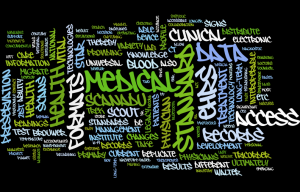 There is an abundance of current and emerging information technologies in which physicians can have timely and ease of access to a patient’s medical health condition thereby allowing them to provide their patients with accurate diagnoses and ultimately successful treatments. The two technologies that I will discuss and illustrate are data preservation of Electronic Health Records (EHRs), and the current development Scanadu Scout, a 21st century medical “tricorder” based on the original Star Trek television show.
There is an abundance of current and emerging information technologies in which physicians can have timely and ease of access to a patient’s medical health condition thereby allowing them to provide their patients with accurate diagnoses and ultimately successful treatments. The two technologies that I will discuss and illustrate are data preservation of Electronic Health Records (EHRs), and the current development Scanadu Scout, a 21st century medical “tricorder” based on the original Star Trek television show.
A variety of different types of medical data exist in patient medical records. These data take a number of different formats, such as lab test results, CT scans, EKGs, X-rays, etc. These records must remain easily accessible to medical personnel and be easy to access and search. “The ability to apply standard and interoperable solutions to manage and preserve EHRs (lab test results, CT scans, physician notes, etc.) and migrate, distribute, replicate, and access these records from legacy formats and platforms to advance standard formats and operating systems are vital for clinical care and medical research.” Researchers at the National Institute of Standards & Technology, through collaboration with government standard development organizations, and industry, are working at creating a “standard preservation infrastructure to support a wide variety of EHRs, data formats, and delivery mechanisms as well as identify, evaluate, and integrate standard and best practice long-term preservation and management tools to migrate, replicate, and distribute EHRs.” Through this project, researchers will be able to:
- Design and develop a universal messaging mapper to parse and analyze an extensive range of protocols,
- Store clinical data in a universal archetype-based record format, and
- Develop system that allow for long-term searching, retrieval, and access of stored EHRs.
While establishing an interoperable framework enabling the exchange of EHRs between legacy and future EHR formats and capturing clinical knowledge independent from technology and concurrently providing a standard interface, physicians and health professionals will ultimately be able to access and update clinical knowledge, thereby providing higher-quality treatment at the point- of-care. (Chang, NIST).
Scanadu Scout, similar to the medical tricorder on Star Trek which is “designed and programmed” to be a diagnostic tool measuring vital signs and used by Dr. McCoy in “field treatment” situations on a particular planet, also monitors hearty heart, temperature, Sp02, and systolic and diastolic blood pressure-cuffless in under 40 seconds. A person can take readings by holding the device to their left temple. The data is then sent to their smartphone via Bluetooth where they can track and trend their vitals over a period of days, weeks or months. Scanadu Scout also affords users the ability to save past scans and monitor their personalized baselines as a result of their vital signs. While this device allows for personal health management and improvement, it is not a substitute for a primary care physician or specialist. With these readings or any noted and significant changes in weight loss, blood pressure, or blood sugar, patients should contact and consult their primary physician regarding treatment or decision making in terms of new prescriptions or changes in dosages. Walter de Brouwer, the CEO and founder of Scanadu profoundly predicts that “as we become more informed about our health, doctors will no longer act as accountants of our health records but information analysts.” (Profile, 2015)
REFERENCES
National Institute of Standards and Technology. “Long-term Data Preservation and Management of Electronic Health Records,” available online at http://www.nist.gov/healthcare/emerging/recordpreservation.cfm, last accessed Nov. 21, 2015.
Palestine, Eileen & Mandel, Geoffrey (eds.) Star Fleet Medical Reference Manual, (1977). Paramount Pictures Corporation.
Profile: Walter de Brouwer. (Fall, 2015). Active Over 50, pp. 16-19)